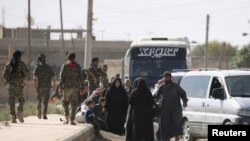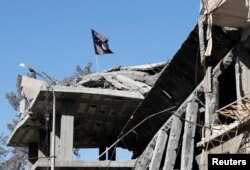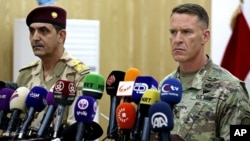Officials of the U.S.-backed Syrian Democratic Forces (SDF) are dismissing claims they brokered a covert deal with the Islamic State last month to allow safe passage to hundreds of besieged IS fighters evacuating from Raqqa, the de facto capital of the so-called Islamic State in northern Syria.
The BBC on Sunday reported it had uncovered details of a pact between the SDF and IS, with the blessing of the U.S.-led coalition, to allow hundreds of suspected IS fighters and their families escape from Raqqa.
The report claimed the deal enabled about 4,000 people, including hundreds of IS foreign and local fighters, to be evacuated by a fleet of trucks toward the border region in eastern Syria, and they then fanned out across the country and into parts of Turkey.
During an interview with VOA, U.S.-backed SDF spokesperson Mustafa Bali described the charges as a “misrepresentation” of an attempt by local tribal leaders to open a safe route for civilians caught in the fierce fighting for the city, which came under full SDF control last month.
“What happened was an effort by Arab tribes and residents of Raqqa to evacuate 3,000 to 5,000 civilians, mostly children and women, trapped in the city,” Bali told VOA.
“This was not done secretly, but announced to the public at that time,” he emphasized.
Bali did not rule out the possibility, however, that some IS fighters might have taken advantage of the opportunity and mingled with civilians to escape the city.
“Did some [IS] people hide among 3,000 to 5,000 civilians and manage to escape? That can happen,” Bali added.
‘Surrender or get killed’
Bali said as civilians were being evacuated out of the city, 275 IS members handed themselves over to the SDF.
Those who refused to submit, “We told them, ‘You have two options; surrender or get killed,’ and that happened,” Bali said, referring to the fate of the remaining IS fighters who opted for the latter option. They were eliminated as the SDF stormed the city.
During the last days of the operation for Raqqa, the SDF estimated up to 500 IS fighters, local and foreign, remained in the city. The coalition put the number lower, at 300 to 400 fighters.
While U.S. Army Colonel Ryan Dillon, the spokesman for the U.S.-led coalition fighting IS, would not confirm the deal, he did not rule out the possibility of IS fighters evacuating with the crowd.
“This [convoy of trucks carrying people] is not our ideal,” Dillon told VOA on Tuesday. “We did not want a negotiated surrender.”
Dillon estimated the number of potential IS fighters who could have escaped at 300, adding that about 100 additional IS fighters tried to take the deal after the convoy had left, but by then it was too late.
Biometric verification
Dillon said as part of the “convoy agreement,” U.S.-backed fighters had gathered and processed biometric data from all potential fighters. That screening led to the discovery of four foreign fighters in the convoy, who were identified and detained by the SDF.
The coalition spokesperson said the argument for the SDF role has been that the negotiated deal would prevent further civilian casualties as the battle for Raqqa intensified. The U.S.-led coalition has often complained that IS fighters’ use of civilians as human shields hindered air and ground offensives against the terror group.
Meanwhile, French army spokesman Patrik Steiger, whose country has contributed to strikes against IS in Syria and has special forces operating in Raqqa province, said the coalition could not take action against the IS convoy because of concerns about civilian causalities.
“It was monitored by drones, [but] the terrorists were mixed in with the population, which prevented airstrikes being carried out,” Steiger told reporters in a weekly briefing Thursday.
Backlash
Experts say the alleged deal likely would face domestic and foreign backlash, particularly from those who have been critical of U.S. support for the Kurdish element of the SDF, known as the YPG.
Turkey, which views the YPG as a terrorist organization, has said it was appalled by the U.S. stance on the deal.
Nicholas Heras, a Middle East expert at the Center for New American Security, said the deal, as alleged, could have been used by Syrian President Bashar al-Assad and his supporters, such as Russia, which have questioned the U.S.’s intentions in fighting IS in Syria.
“When the Assad government and Hezbollah made the deal to remove ISIS fighters from the Syrian-Lebanese borders, the U.S. made a very distinct point about that,” Heras told VOA, using an acronym for the militant group. “Assad allies saw the opportunity to turn the tables on the U.S. and tried to point out the hypocrisy of the U.S. decrying Assad-Hezbollah’s deal with ISIS — and comparing it to the U.S.-led coalition’s approving of a deal made between SDF and ISIS in Raqqa.”
By sparing civilians and making the Arab element of the SDF take the lead in the negotiated deal, Heras said, the SDF had a strategic interest to win over the hearts and minds of the Arab tribes of Raqqa.
“The dynamic at play here is that the SDF listened to its Raqqa Arab tribal partners that said, ‘Look, if you continue to press this offensive and thousands of civilians are killed as a result, this will cause a horrible degree of enmity that will actually open the door for insurgency and destabilizing activities after defeating ISIS in Raqqa.’ That could also challenge the mission of the U.S.-led coalition campaign to bring stability,” Heras added.
Those opposed to the SDF control of Raqqa have accused the SDF of being a Kurdish-dominated front with an ethnic agenda.
VOA’s Mahmoud Bali from Syria and VOA Pentagon correspondent Carla Babb from Washington contributed to this report.












